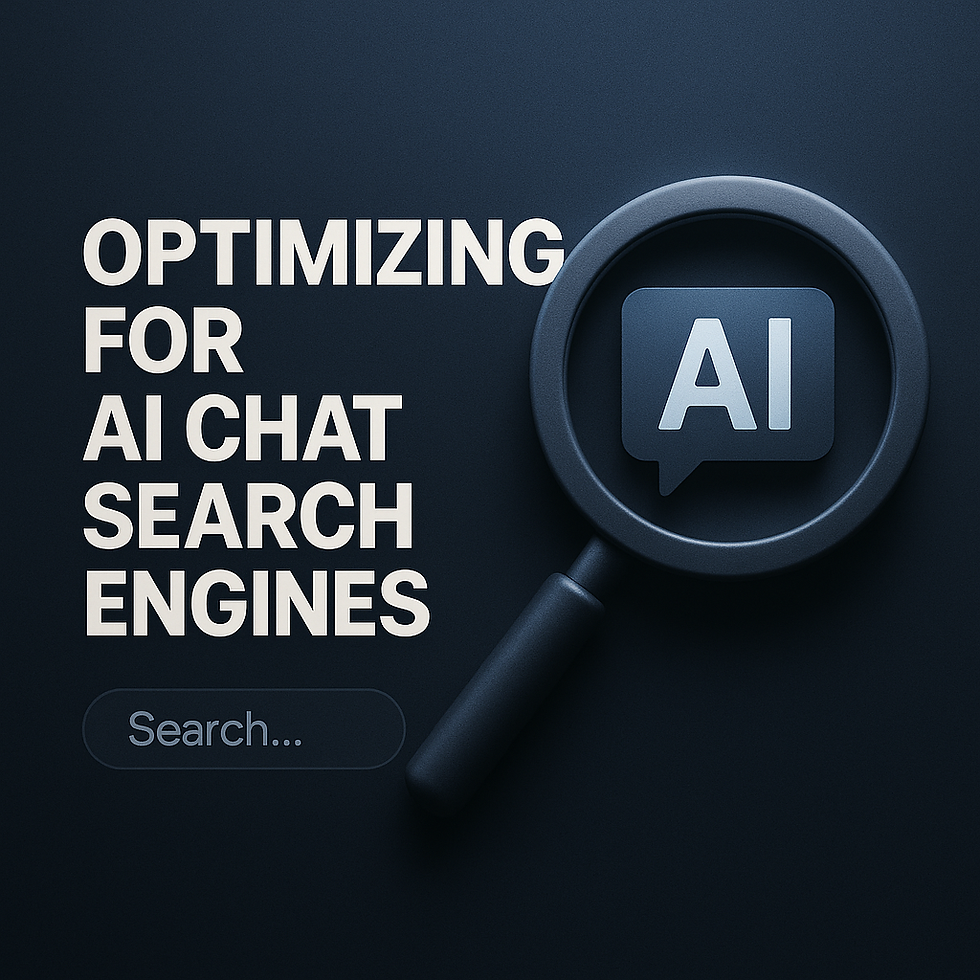AI Chat as the New Search Engine: How to Win Traffic, Citations, and SEO in the Era of Answer Engines
- Lord Of The Wix

- Sep 1
- 4 min read
Introduction: The New Search Paradigm
Search is no longer ten blue links. The rise of AI chat search engines—from Google AI Overviews to Bing Copilot, Perplexity, Anthropic Claude, Brave AI Answers, You.com, and even DuckDuckGo AI Chat—is transforming how people discover information.
Instead of scanning multiple pages, users now type a conversational query and receive direct, synthesized answers with citations. This shift threatens the old model of click-through SEO but creates new opportunities for sites that can become the trusted sources these AI systems quote.

This article explores the full ecosystem, shows the data driving the change, and gives you a detailed playbook to secure visibility, traffic, and trust in this new world of Answer Engine Optimization (AEO).
1. The AI Search Ecosystem (2025)
Google: AI Overviews & AI Mode
Rolled out in 100+ countries with 1 billion+ monthly users.
Integrates summaries, inline citations, and more links in AI AI ChatMode.
Impacts the world’s ~90% search market share.
Microsoft Bing: Copilot
Conversational search integrated with Windows 11 and Edge browser.
Sources appear as citations with contextual snippets.
Still small (~4% market share) but strategically influential.
Perplexity AI
Branded as an “Answer Engine.”
Always cites multiple sources.
Millions of daily active users; introduced a Publisher Program to share revenue with cited content providers.
Anthropic Claude
Provides direct, cited answers when using web-enabled search.
Particularly popular among researchers and professionals.
Brave Search + Summarizer
Independent search index.
Summarizer provides AI-written answers with citations above search results.
Supports chat-like iterative queries.
You.com (YouChat)
“Chat-first” search with citations and multimodal results.
Positions itself as a privacy-focused alternative to Google.
DuckDuckGo AI Chat
Offers anonymous access to AI models (GPT, Claude, Llama).
Represents privacy-first adoption of AI Q&A.
2. The Data Driving the Shift
Zero-click searches: ~60% of Google searches end without a website click.
AI impact: Users exposed to AI summaries click about half as often as those who see only classic SERPs.
Chat adoption: ChatGPT dominates, but Copilot and Perplexity are steadily growing.
Traffic shift: Perplexity and Claude always cite; inclusion here creates new visibility even if CTR is lower.
3. How AI Search Changes SEO
From ranking to referencing.The game isn’t just “rank #1” anymore—it’s “be cited as a trusted source.”
Entity and expertise signals matter more.AI systems prefer authoritative, transparent sources with clear authorship.
Freshness and facts over fluff.AI prefers content with statistics, structured data, and evidence.
Citations = brand lift.Even if clicks are fewer, being cited repeatedly builds authority and captures brand-aware users.

AI Chat
4. Platform-Specific Optimization
Google AI Overviews
Strategy: Write answer-first content (40–80 word summaries up front).
Use schema: FAQ, HowTo, Product, Organization.
Maintain freshness: Update dates, changelogs, and “last reviewed” stamps.
Bing Copilot
Strategy: Implement IndexNow for instant crawling.
Ensure structured content with clear headings and answer blocks.
Use Open Graph/Twitter metadata for better link previews.
Perplexity
Strategy: Allow PerplexityBot in robots.txt.
Use data tables, key takeaways, citations to primary sources.
Participate in their Publisher Program for potential revenue.
Anthropic Claude
Strategy: Provide evidence-rich pages with verifiable statistics.
Use anchor links and clean HTML for better quoting.
Brave AI Answers
Strategy: Create concise, authoritative explainers with citations.
Avoid fluff—Brave favors sources that summarize well.
You.com & DuckDuckGo
Strategy: Maintain strong structured SEO and privacy-compliant content.
YouChat often cites direct definitions and Q&A content.
5. Technical SEO for AI Chat
Schema & Structured Data: Use JSON-LD for FAQ, HowTo, Products, Organization.
Answer-first formatting: Place the direct answer above the fold.
Citations out: Link to primary, reputable sources.
IndexNow: Send update pings to Bing, Seznam, Yandex (Google not yet).
Robots.txt policy:
Allow PerplexityBot if you want citations.
Control training bots (Google-Extended, GPTBot) separately.
Jump links: Create anchors for key sections—AI often deep-links to specific parts.
6. Content That Gets Cited
Original research: Benchmark reports, surveys, studies.
Definitions: “What is [X]” content with clear language.
Comparisons: Feature or pricing tables.
Procedures: Step-by-step guides.
Regulatory explainers: Summaries of laws, codes, standards.
AI Chat
7. Measuring Success
Track referrers (Perplexity, Bing Chat, Brave).
Monitor brand search growth as proxy for citations.
Run manual queries in AI chat engines to see if you’re cited.
Watch direct traffic and newsletter/demo conversions—not just organic clicks.
8. Risks & Challenges
CTR decline from AI summaries.
Higher content quality bar—thin content gets buried.
Publisher economics: unclear compensation models, though Perplexity and others are experimenting.
Bot load: AI crawlers increase traffic; configure rate limits wisely.
9. Solutions & Opportunities
Shift KPIs from “rankings” → citations + conversions.
Publish unique, verifiable data.
Invest in E-E-A-T (Expertise, Experience, Authority, Trust).
Refresh and expand content quarterly.
Build original research assets to become the canonical source.
10. Example Case Studies
Travel blog with “What is the Schengen Zone?” → Frequently cited in Perplexity, boosting brand searches even though clicks are fewer.
Software company publishing benchmarks → Picked up by Copilot answers, driving demo requests.
Finance site summarizing EU regulations → Consistently referenced in Claude answers, creating inbound links from secondary sources.
Conclusion: From SEO to AEO
AI chat search isn’t the death of SEO—it’s SEO 2.0. The unit of visibility is no longer just “ranked page” but cited paragraph.
If your content is:
Clear, concise, and answer-ready
Backed by data and evidence
Marked up for machines
Fresh and trustworthy
…then you can thrive in the age of AI search, earning citations, authority, and the highest-value clicks that remain.


Comments